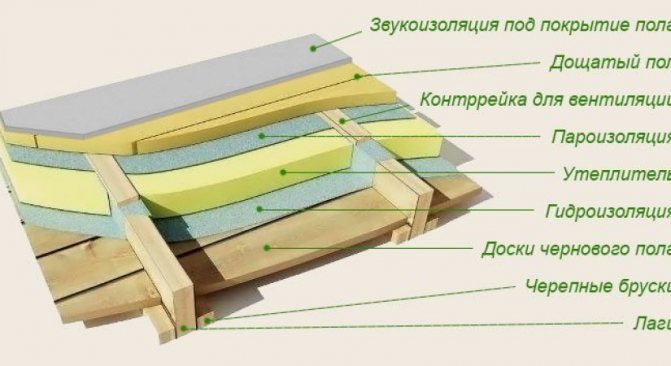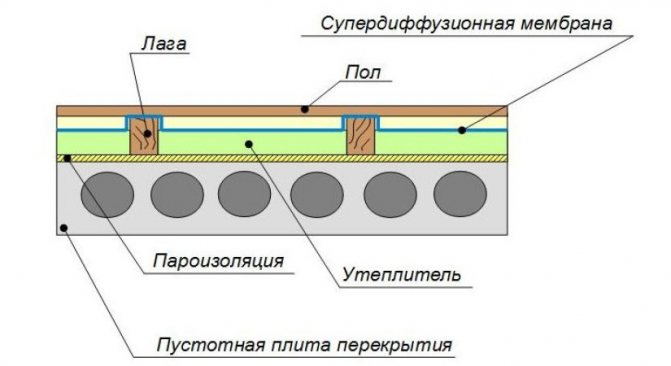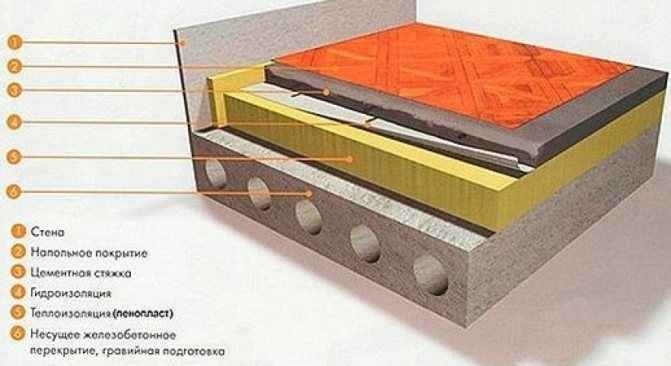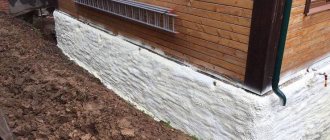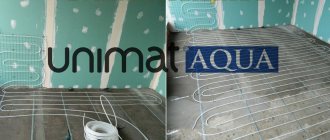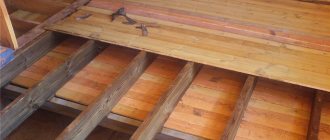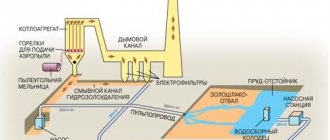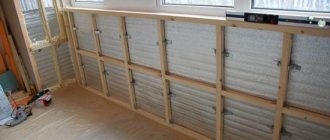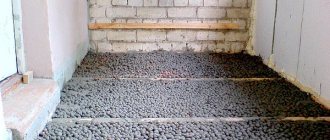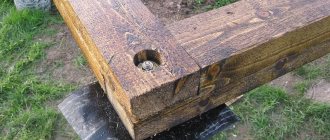Features of expanded polystyrene
Modern polystyrene foam is a cheap material that is widely used both in country houses and city apartments. It is made by thermal swelling of polystyrene granules. As a result, the granules are sintered, forming a white material.
Section of the floor insulated with expanded polystyrene
Each of the expanded polystyrene granules consists of many microscopic cells with air. This can explain the extraordinary lightness of the material, because 97% of its composition is air voids.
Main varieties
Modern expanded polystyrene is represented by the widest range of brands that differ in thickness and performance properties. However, they are grouped into five groups:
- non-pressed expanded polystyrene (in particular, PSB-S, ЕРS, etc.);
- autoclave (Stirofoam);
- extruded (Penoplex, XPS, etc.);
- extruded autoclave;
- pressed (PS (from 1 to 4), other foreign brands).
Expanded polystyrene of the PSB-S-35 brand.
If you need to insulate the floor on the first floor of the house, then it is better to use the material of the PSB-S-35 brand. Such boards are characterized by low thermal conductivity (0.4 W / m²) and moisture absorption (maximum 2%).
With a heavy load, it is recommended to opt for the PSB-S-50 brand. This is the ideal solution for garage and other utility buildings.
Video - Production of extruded polystyrene foam
Material advantages
- Low thermal expansion + low thermal conductivity. Due to this, 10 cm of expanded polystyrene is comparable in properties to 40 cm of wood and 2 m of bricks.
- Environmental friendliness - the material does not harm health at all.
- The material is durable.
- Styrofoam has excellent sound insulation properties.
- It is also very durable, capable of withstanding significant loads.
- Its structure does not change with temperature drops.
- The material is resistant to moisture, that is, it does not swell or dissolve in it.
- It is resistant to aggressive environment of chemical and biological nature - to soap, bleach, salt solutions, bacteria, etc.
That is why expanded polystyrene is the best option for thermal insulation of the floor. The only negative is that it dissolves under the influence of organic resins.
Note! Recently, they began to produce slabs of different colors - green, red, blue. But this does not affect the properties and even more the cost of the material.
Floor insulation material
The construction market offers a wide range of materials for floor insulation. They differ in cost, installation technology, optimal operating conditions, etc.
Mineral wool for floor insulation
Materials used for floor insulation in a wooden house from below:
- mineral wool;
- ceramisite;
- penofol;
- polystyrene or expanded polystyrene;
- sawdust;
- penoplex;
- ecowool.
Each of the materials has its own advantages and disadvantages. The choice of it as a heater depends on the characteristics of the house, the financial capabilities of the owner and the type of flooring.
Penoplex is a common foamed polymer. It is distinguished by high strength, ability to keep its shape well. For the production of foam, the extrusion method is used. This allows for a strong structure with a large number of small cells inside for better heat transfer. Moisture does not penetrate inside the holes, so the material does not need additional waterproofing.
Penoplex does not need additional waterproofing
Mineral wool
Mineral wool is used most often as a heater. It is lightweight, does not burn, and has a high degree of protection against extraneous sounds.
There are three types of this material:
- glass;
- slag;
- stone.
You can use rolled mineral wool for floor insulation
This material is produced in the form of a dense plate or flexible mat. For ease of installation, the plates are marked with a blue stripe. This allows the sheets to be positioned in the desired direction.
The big disadvantage of this material is the ability to absorb moisture. Therefore, when insulating the floor in a private house with your own hands, it is necessary to conduct a good vapor barrier.
Additional insulation of pipes with mineral wool insulation
Expanded clay is small round porous balls of shale or clay. They are obtained by firing materials in a furnace at a high temperature. Expanded clay is considered a safe and environmentally friendly material. Among its advantages should be highlighted:
- high sound insulation;
- resistance to low temperatures;
- environmental safety for humans.

A noticeable disadvantage of this material is its own weight seal. Expanded clay balls are pressed together. This leads to an increase in the weight of the substance and a decrease in thermal insulation properties.
Expanded clay is often used to insulate a wooden floor
Sawdust is a waste product of the woodworking industry. They have good steam and sound insulation characteristics, retain heat, and are environmentally friendly for humans. Sawdust is of low cost. The resulting thermal effect is not worse than that of expensive materials. Thanks to the cement component, they are also well suited for floor insulation in a ground floor apartment. Subsequently, such a screed can be used for laying laminate, linoleum, tiles, etc.
Before use, the sawdust is subjected to a special treatment. This prevents the appearance of rodents and beetles in them. After that, they are mixed with cement and water and evenly applied over the entire area of the flooring.
Sawdust is a very cheap material for floor insulation.
Sawdust is ideal for insulating floors on the ground, especially if the building does not have a solid and solid foundation.
Floor insulation with expanded polystyrene is popular. Most often, this material is called foam. The advantages of this insulation:
- low vapor and sound permeability;
- low thermal conductivity;
- resistant to external factors and chemicals;
- does not lose its properties for a long time;
- easy to install.
Polyfoam is not afraid of fire and exposure to high temperatures
A significant drawback of foam is its susceptibility to moisture. He can absorb it into himself. This negatively affects the basic performance characteristics. He is also afraid of the effects of fire and high temperatures. But a simple and inexpensive technology for insulating floors with polystyrene is its significant advantage. This is what, in most cases, the owner of the house is guided by.
Ecowool
Polyurethane foam (ecowool) is a great way to solve the problem of floor insulation in an apartment on the ground floor and in a private house (dacha). This material is blown into the free space using a compressor. In this way, he evenly fills all the voids. Small particles that make up ecowool provide excellent vapor barrier.
After hardening, a solid, even layer is obtained. It can withstand the load perfectly. Light weight does not increase the weight of the structure. The service life of this insulation is more than 20 years.
Thermal insulation of a wooden floor with ecowool
A significant disadvantage of ecowool is the need to use special industrial equipment.
The combination of polyethylene foam and a thin layer of aluminum foil is called penofol. It is sold as a rolled roll. The thickness of the seal is from 3 to 10 mm. Penofol retains heat well, is environmentally friendly, and has high sound insulation.
Penofol retains heat well
The big disadvantage of this material is exposure to moisture due to the presence of aluminum foil in the composition. Another disadvantage is that penofol does not differ in long-term operation. After five years, it is necessary to re-insulate.
The modern market offers a wide range of materials suitable for insulating a wooden floor on logs. You can find the properties of the most commonly used heaters in the following table.
Table. Popular heaters
| Heat insulating material | Basic properties |
| Sawdust | One of the most budgetary, and sometimes completely free thermal insulation material. It is characterized by good thermal insulation properties, helps to normalize the level of humidity inside the floor structure. The main disadvantage of sawdust is its poor resistance to the effects of various kinds of insects, fungi and other harmful microorganisms. In addition to this, the material supports combustion, which is also a big disadvantage. |
| Mineral wool insulation | Materials based on mineral wool are characterized by high thermal insulation properties and do not support combustion. Along with this, the material does not tolerate contact with moisture poorly - it swells under the influence of water and loses its original performance characteristics. If mineral wool is used for insulation, waterproofing will need to be equipped on both sides of the material. |
| Expanded clay | A relatively inexpensive and easy-to-equip material with good thermal insulation characteristics. For insulation, it is recommended to use granules of different sizes - so the backfill will turn out to be denser. |
| Styrofoam | One of the most popular heaters. It is sold at a relatively affordable cost, provides highly effective insulation, is not afraid of contact with moisture, but supports combustion, while releasing substances that are unsafe for human health. In addition, the foam attracts rodents, "encounters" with which do not in the best way affect the service life of the material. |
- Bulk;
- Bulk;
- Roll;
- Tiled (block);
- Sprayable.
Various types and types of heaters for a wooden floor (bulk, spray, roll, block)
For insulation, you can choose:
- Styrofoam;
- Penoplex;
- Expanded clay;
- Glass wool;
- Cork material;
- Reflective insulation (penofol);
- Cellulose;
- Gypsum fiber;
- Fiberglass;
- Foam glass;
- Polyurethane foam.
- Drill with various drills;
- Screwdriver;
- Saw;
- Plane;
- Electric jigsaw;
- Construction mixer.
Read next: Vacuum cleaners for dry cleaning in the online store Thomas
Fire safety. Modified and unmodified polystyrene foam
Untreated material is highly flammable from a lit match or sparks from a welding machine. At the same time, it cannot catch fire from a cigarette or a red-hot metal object.
Modified polystyrene foam (self-extinguishing)
Expanded polystyrene can ignite at temperatures from 200 ° C to 450 ° C, in this case it all depends on the additives used in the production.
Note! The ignition temperature must be indicated in the certificate that comes with the plates.
If ordinary unmodified polystyrene foam is burning, then the temperature around it can exceed 1200 ° C (although not for long). During combustion, toxic substances such as cyano- and hydrogen bromide, phosgene are released.If special additives were used, then the combustion temperature is reduced to that which is normalized for each specific grade of material.
In the manufacture of modified polystyrene foam, fire retardants (substances that prevent combustion) are used. In this case, the material is already considered self-extinguishing and is designated by the letter "C" at the end of the abbreviation (for example, PSB-S).
There is another way to reduce the flammability - when the granules swell, the flammable inert gas is replaced by non-flammable carbon dioxide.
Floor insulation with expanded polystyrene
There are several floor insulation technologies that differ in the material of the topcoat:
- insulation on the ground;
- wood insulation;
- insulation of the concrete floor.
But it is worth noting that the installation procedure for floor insulation is the same for all coatings. There are, of course, some nuances, but we will get acquainted with them a little later.
Sequence of work
Below is the technology of insulation under the screed, but it is almost completely applicable for other methods.
Floor insulated under screed
Step one. Prepare the base. If there is no concrete or wood, then the preparation consists in compacting the earth and preliminary (or rough) leveling of its surface.
Step two. Fill in a 10-centimeter cushion of rubble, tamp and flatten it too.
Step three. Fill in the next layer of fine grained sand to hide the sharp edges of the rubble and fill the voids in it.
Step four. Lay the polystyrene foam plates with an overlap (modern products allow you to do this - the end parts in them have special cutouts).
Laying slabs on a prepared pillow
Step five. Lay the waterproofing membrane, also overlapping. Seal the joints with assembly tape.
Step six. Next, install a reinforcing mesh to give strength to the future structure and evenly distribute the loads (instead of a mesh, you can install wooden logs, but more on that later).
Step seven. Pour the concrete screed. The concrete layer must be at least 5 cm to withstand the loads.
Step eight. The final part of the work. After the concrete has dried, finish its surface, lay additional materials as desired (parquet, linoleum, etc.).
Note! Leave a two-centimeter technical gap between the walls and the floor along the entire perimeter of contact (for waterproofing or possible thermal expansion). Fill the gap with polyethylene foam.
Video - Expanded polystyrene
Thermal protection of the floor located above the ground
How to insulate the floor with expanded polystyrene in rooms located above a low subfloor? Floor insulation on the ground differs from other technologies in that the heat insulator is in direct contact with the ground. Therefore, special attention should be paid to the waterproofing device, since the earth is exposed to groundwater and melt water. The floors on the ground are insulated according to the following scheme:
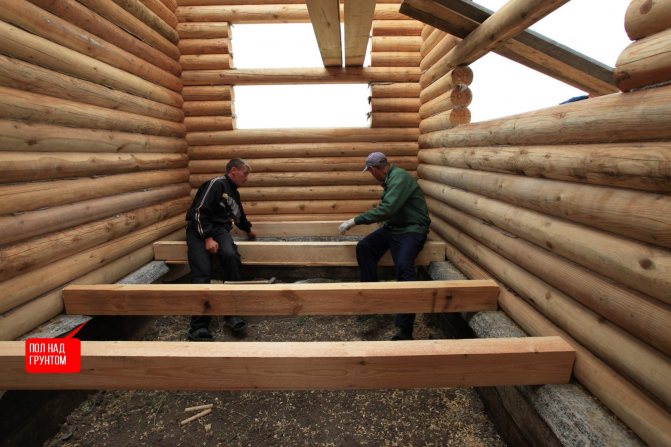

- Dismantling skirting boards and old flooring.
- Leveling the soil with subsequent compaction.
- Arrangement of a crushed stone base 30 - 40 cm thick.
- Backfilling of a layer of sand and layer-by-layer compaction.
- Installation of reinforced mesh and pouring concrete screed.
- Laying a layer of waterproofing from dense polyethylene or foil.
- Lay the floor insulation on the ground. Expanded polystyrene is placed on the floor in a checkerboard pattern, eliminating the voids between them with polyurethane foam.
- Spreading overlapping sheets of waterproofing material, sealing the seams and edges with special tape.
- Arrangement of reinforced concrete screed with a thickness of at least 50 mm.
- Finishing floor layer of decorative finish.
The result will be better if you fill it with polystyrene concrete. Concrete with added polystyrene chips has an increased heat-shielding property.
Features of floor insulation in the loggia
Loggias differ in that the floor level in them is almost always lower than in the apartment. Therefore, in this case, insulation must also be carried out using wooden logs. Fill the steam-line membrane on the expanded polystyrene plates, and then mount the board covering.
Note! It is advisable to insulate the floor even before entering the apartment, while there is no furniture, or at the stage of building a house. And if you use extruded polystyrene foam, you can further improve sound insulation.
Recommendations for floor insulation with extruded polystyrene foam
- The installation of a floor with extruded polystyrene foam requires a certain preparation of the surface: it must be clean, dry and even. If necessary, use a cement screed.
- The plates should be joined as tightly as possible. As a rule, special grooves have already been made in them to ensure reliable alignment.
- When the floors are made of extruded polystyrene foam, thermoacoustic tape is usually laid along the walls.
- When insulating floors, waterproofing is also placed on the XPS boards - usually it is a plastic film that is laid with an overlap, and its edges are bent by about 6 cm.
- Further, the device of the floor with expanded polystyrene continues with a cement screed, the thickness of which must be at least 5 cm.
- If a wooden floor is insulated with extruded polystyrene foam, then instead of a cement screed, the coating is immediately laid.
Why is floor insulation necessary?
The floor is the only surface in the house that cannot be avoided. Therefore, it is important to keep it at a comfortable temperature. Warm air heated by radiator heating batteries rises, and if the floor is not insulated enough, it is unpleasant to walk on it.
When using a floor heating system, insulation is also necessary. In its absence, the coolant will not give energy rationally, heating not only the floor covering, but also the underlying cooled layers.
The lack of full-fledged floor insulation leads not only to overspending on heating, but also to damage to structures by mold and fungus. Condensation falls on the warm air side, and a humid environment is beneficial for the development of dangerous microorganisms.
How to choose polystyrene foam for floor insulation
When you need extruded polystyrene foam for your flooring, you will find that there is a wide variety of products. The thickness of the slabs can be either 20 or 100 mm. In addition, they have different technical characteristics such as compressive strength and thermal conductivity. Proceed from what load you put on your floors - so, for a garage floor, the insulation should have much greater strength than for a living room or a loggia, where there are enough slabs with a density of 30-35 kg / m3. The degree of insulation depends on the thickness of the material. Plates for underfloor heating can be thinner, but if heating is not provided, then extruded polystyrene foam for laying a floor, wood or laminate, is better to take thicker. Take into account the flammability class, which can also be different. Plates also differ in the form of the joint: it can be a step, a thorn-groove, a smooth joint.
For extruded polystyrene foam for the floor, the price depends primarily on the density: for example, a square meter of heat-insulating floor boards with the same thickness of 50 mm can cost either 200 rubles or 260 rubles. Prices for a cubic meter for XPS of different brands differ by 10 -15%: for example, Tepleks offers expanded polystyrene with a density of 35 kg / m2 suitable for flooring. cub. at a price of 3800 rubles. per cubic meter, Primaplex - 4200 rubles each, and Technonikol - 4300 rubles. per cubic meter.
Insulating floors with extruded polystyrene foam is a great way to save energy. Indeed, through cold floors, the room can lose up to 20% of the heat. It would be correct to take this into account even during construction.However, it is never too late to insulate your home, and modern building material is the first assistant in this.
Heating costs directly depend on the high-quality thermal insulation of the structural elements of the building. Particular attention should be paid to the thermal protection of the floor, through the surface of which up to 20% of heat is lost. Modern building technologies offer a good and affordable option for thermal insulation - floor insulation with expanded polystyrene.
Expanded polystyrene insulation has a uniform closed-cell structure, which includes polystyrene microgranules filled with carbon dioxide. The most famous polystyrene materials, which have the same chemical composition, but differ in the production method, are polystyrene and extruded polystyrene foam. The first of them is obtained by exposing the polystyrene granules to water vapor, and the other by extrusion. The result is transparent or colored sheets.
Which one is more suitable for protecting against floor heat loss? Thermal insulation of the floor using extruded polystyrene foam, which has a high density, is somewhat more expensive, but much more effective. Expanded polystyrene for the floor has excellent heat-saving and sound-absorbing properties. It practically does not absorb moisture, is fire resistant and environmentally friendly. The leaders among sales are heaters of the following brands: Penoplex, TechnoNIKOL XPS, URSA XPS, Primaplex.
Advantages of using foam in floor construction
Thermal insulation of the floor with foam is a fairly common option, which has gained popularity due to the following qualities:
- ease of installation: there is no need to provide workers with overalls and protective equipment, as is the case with mineral wool or polyurethane foam;
- ease of cutting allows you to insulate the floor in a room of any geometric shape;
- the cheapness of the material in comparison with other effective insulation materials in many cases becomes a decisive factor;
- can be used to insulate the underfloor heating system;
- resistance to the appearance of mold, fungus and other microorganisms harmful to humans allows us to call the material safe, not causing allergic reactions.
These positive qualities make the material suitable for use in house building from any material.
Installation technology
Before insulating the floor with foam, you need to understand the features of its use for various structures. The laying process itself is as simple as possible, but the material requires an additional protection device against moisture and steam.
Insulation of the floor of the first floor
There are no big differences when working in a brick, concrete or wooden building. Insulation of the floor with foam is carried out both from the top of the floor and from the bottom. The method from below is more competent from the point of view of heat engineering, but it is very laborious. In the overwhelming majority of cases, insulation is performed over the floor.
Styrofoam can be laid on logs or under a concrete screed. In a wooden house, it is appropriate to use insulation between the logs.
If desired, you can lay the material along the logs and with concrete floors, if you are planning wooden floors.
Installation on lags is carried out in the following order:
- preparation and cleaning of the base;
- laying waterproofing material;
- lag layout and their fixing;
- styling foam;
- laying vapor barrier;
- installation of a clean floor.
For polystyrene, installation on logs compensates for its low strength. When laying under a screed, it must be additionally reinforced, which leads to an increase in the cost of construction or repair. Read more about floor insulation under the screed.
In a wooden building, it is not recommended to use polyethylene film as a waterproofing and vapor barrier. Better to choose a more expensive breathable material.
Use as soundproofing
To prevent noise penetration, a layer with a thickness of 30-50 mm can be used. The overlap cake should look like this:
- overlap;
- vapor barrier;
- Styrofoam;
- waterproofing;
- clean floor.
The use of expanded polystyrene for thermal insulation of wooden floors
Thermal insulation of a wooden floor on logs with extruded polystyrene foam includes the following measures:
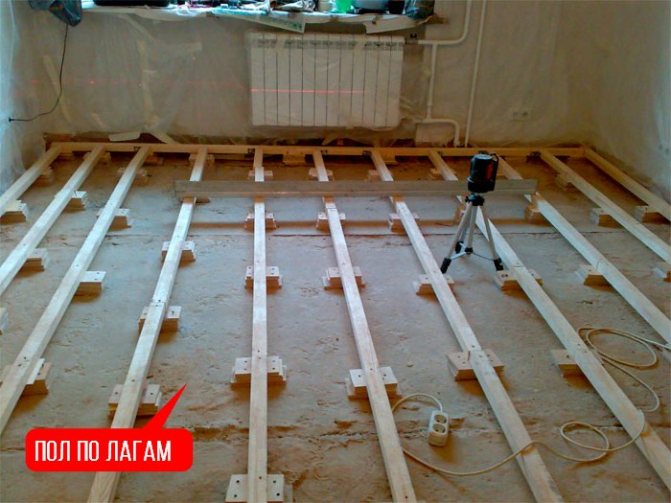

- Dismantling skirting boards and existing flooring;
- Inspection of the elements of the wooden system, repair and replacement, if necessary, of rotten parts of the support bar, log and rough flooring;
- Impregnation with fire retardant and antibacterial solutions of all areas of wood;
- Installation of a waterproofing layer. A polyethylene or foil film is placed between the logs, while the edges should go to the ends of the log and the side surface of the walls by 10 - 15 cm.
- Plates of expanded polystyrene make an insulating layer between the logs on top of the rough flooring, connecting them to each other with grooved ends. Gaps and slots are filled with polyurethane foam or special glue with pieces of expanded polystyrene;
- The device of a vapor barrier layer. Cloths of a profiled membrane or a dense polyethylene film are laid with an overlap, the size of which is 15 - 20 cm, and fixed to the logs with construction tape. Seams and edges are glued with special adhesive tape.
- Re-assembly in a wooden house of a boardwalk, the floorboard of which is pre-impregnated with a fire retardant and antiseptic compound.
Calculation of the thickness of insulation
In a private house, it is allowed to take the thickness of the insulation layer "by eye", but if you wish, you can master the program to perform calculations. It is called "Teremok" and is freely available. Working with this software is simple. Even a person who is far from construction can deal with this. The calculation will help to provide the necessary thermal protection with minimal costs.
The floors in a private house are a place of great heat loss, especially if they are made of wood without insulation. And in our time, when the heating of the home eats up a large part of the family budget, this is simply unacceptable.
Therefore, the insulation of a wooden floor is an important point in home improvement. You need to pay special attention to this question and do not spare money for insulation.
There are several ways to warm your floor, in this article we will look at several options.
Advantages and Disadvantages of Styrofoam
Thanks to sufficient rigidity and strength polystyrene is mounted on any base of the floor.
In this case, it is not necessary to use a plywood structure, which protects the heat insulator from deformation and evenly distributes the loads on the floor, as with mineral wool insulation.
In the material due to structural integrity fungus and mold do not develop... Water is not absorbed by the foam, which makes it an indispensable insulation for floors in private houses and apartments with high humidity.
Ease of installation... Laying foam can be easily handled by a person without the skills of repair work. The main thing is to correctly calculate the material consumption. Extends the service life of any floor covering due to its ability to evenly distribute loads.
Good heat and sound insulator... Styrofoam is excellent at minimizing heat loss. Perfectly protects against noise from neighbors on the lower floors.
Despite the fact that the foam is harmless and does not have any effect on health, in case of fire gives off toxic fumes... In rooms with high traffic during installation work, it is necessary to create a reinforcing frame that will protect the heat insulator from mechanical deformation.
Another lack of foam is its airtightness.Also, polystyrene exhibits chemical activity and is destroyed when interacting with nitrate-containing paints.
Thermal insulation of a wooden floor with expanded clay
Expanded clay is a fairly well-known material that is used to insulate houses. It has been in use for several decades and has not diminished in popularity due to its high performance data.
It is made of special types of clay, which is processed at high temperatures. As a result, balls of a certain size and a certain density are formed.
Before work, the surface must be cleaned of debris. A broom and a scoop will be a good helper in this matter.


If there are gaps between the floor and the walls, they must be sealed with sand-cement mortar or polyurethane foam.
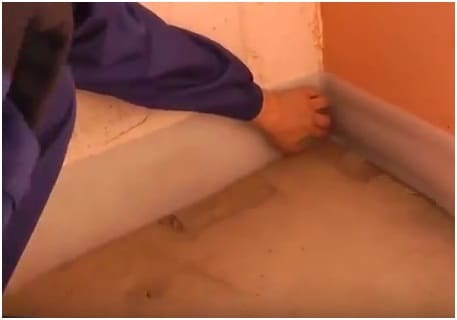

Now, so that when the dry screed expands, the floor does not bend, you need to leave a gap between the floor and the wall. To do this, you can lay a tape of polyethylene foam along the entire perimeter of the wall. Its thickness must be sufficient so that the floor can expand freely.
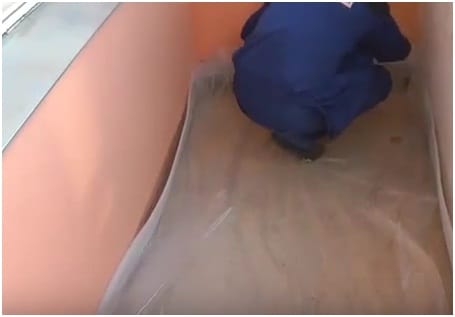

It will not be superfluous to lay a plastic wrap on the base, it will serve as a steam and hydro insulator for us. The film should rise along the edges of the walls just above the level of our future floor. It is best to secure the edges of the film to the wall with masking tape or tape.
Now that the preliminary work has been completed, we can lay a layer of expanded clay.
It should be borne in mind that for insulation it is better to buy expanded clay in which the granules are of different sizes, then the material will be distributed more evenly. The expanded clay layer should be at least 3 cm and no more than 7. Considering this, you can pick up beacons, it can be wooden slats or a metal profile of the required size. It can be fixed to the floor with both cement-sand mortar and self-tapping screws. Beacons must be perfectly level and securely attached.
Now you can scatter expanded clay and level its layer with a rule made from scrap materials.
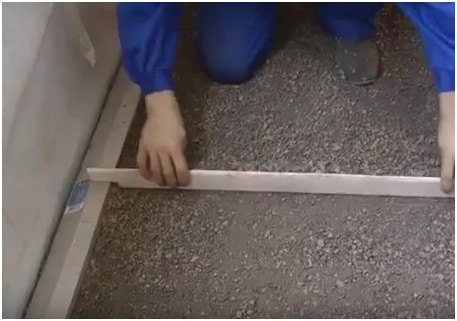

You may not use beacons, but then you will need to align the layer with a rule that has a level indicator. It is much more difficult and not everyone can do it.
It is best to cover such insulation with sheet material. Particleboard, OSB, GVL and even plywood sheets are suitable for this. But it is most practical to use (GVL) - gypsum fiber sheets.
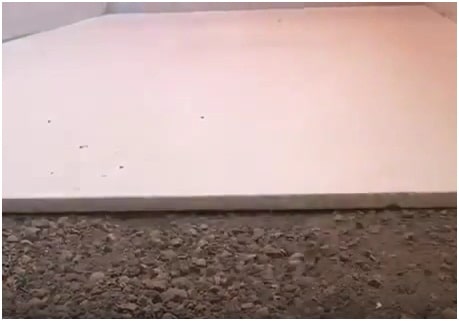

Some, so that expanded clay is not free-flowing, but turns into a solid surface, fill it with cement diluted with water. Such a solution is prepared using a construction mixer.
By pouring expanded clay with it, you will strengthen the surface with a depth of more than three centimeters.
After the plates are laid, the topcoat is already mounted on top. It can be boards, parquet, linoleum and much more, even ceramic tiles.
You can read how to paint the park here, all the detailed instructions that will surely help you in this laborious task.
The use of expanded clay for insulation has a number of advantages, it is not flammable, it is lightweight, keeps heat well and does not conduct sound. It is convenient to work with it, because it gives minimal shrinkage.
Insulation technology with expanded polystyrene
Insulation of a concrete floor using expanded polystyrene granules
Adding granules to the concrete solution allows the concrete floor to acquire thermal insulation properties.
To do this, mix the concrete solution. Add dry cement to a small amount of water and stir with a drill with a special nozzle until the consistency of sour cream. Without stopping to interfere, polystyrene granules are added to the solution. This can be the ratio of concrete to granules as 1: 3 and 1: 6. Than
the more filler, the warmer the floor
... Depending on what hard floor covering the concrete-expanded polystyrene screed will then be covered, the ratio is determined. The more granules, the lower the strength. Also, the screed with granules has a soundproofing quality.
Insulation of floors with expanded polystyrene sheets under a concrete screed
To begin with, the soil is compacted, crushed stone is poured and a layer of sand and a film are covered on top. Then the sheets of material are laid tightly around the entire perimeter of the floor. The joints are filled with polyurethane foam or glued. Lay another layer of film. To protect sheets from mechanical stress
to which the floors are exposed must be laid on the sheets
durable mounting mesh
... Fill the surface with a 40-60 mm thick screed mortar. When the solution hardens, the floor covering is laid.
Insulation of floors on logs
If the floor is made using a log, then it becomes much easier to insulate the floors. To begin with, wooden floor elements are processed antifungal drugs
and moisture protection agents. Then, boards or sheets of chipboard are attached to the self-tapping screws from the lower side of the lags, and sheets of material cut to the size of the opening are laid on them. From above, the covering is covered with foil and floor covering.
Thermal insulation of a wooden floor with mineral wool
The easiest and most reliable way to insulate a wooden floor is to use mineral wool. Usually, the floor structure contains logs, and it is between them that this insulation material is laid.
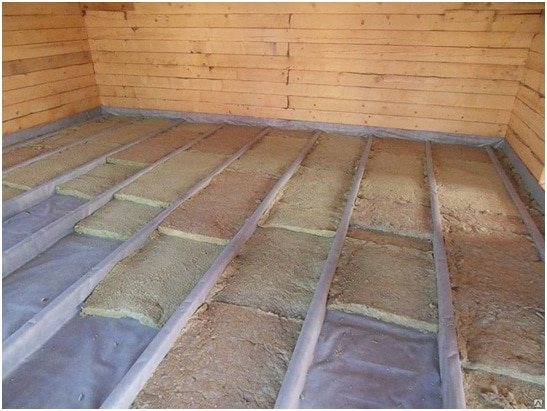

- Before starting work, you must install the plastic wrap. It is advisable to do this before installing the lag. If this is not possible, you can try to push the vapor barrier under the lags, or cut into strips wider a little more than the width of the lag. (Although not the best option).
- When the foil is installed you can place the mineral wool between the logs. There are several nuances here, firstly you need to buy insulation so that its width is slightly wider between the lags, then you do not have to adjust the material in width. You can buy insulation, and then install the logs at the right distance. Further, the height of the installed insulation should be slightly less than the height of the log.
- On top you need to lay a plastic wrap that will protect your mineral wool from moisture penetration. If you do not have such a large film, you can cover everything from several parts, the film should be overlapped with an overlap of at least 10 cm.
- On top of the film, sheet material is laid on the logs, the so-called subfloor. In the role of which the chipboard sheets should act.
